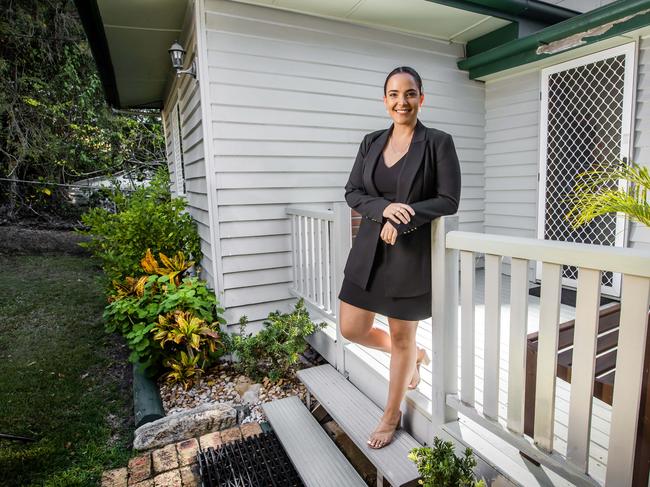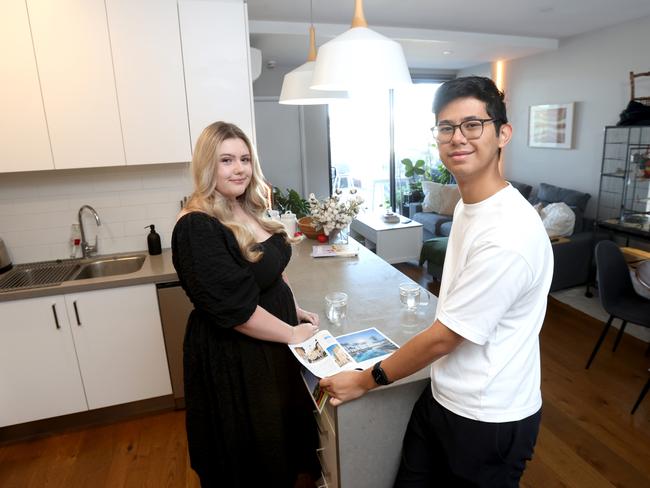Is housing affordability today really that bad?
The maddening generational debate about home buying is one we have all been a part of. And now the answer is finally settled.
Property
Don't miss out on the headlines from Property. Followed categories will be added to My News.
It’s official: Housing affordability in Australia is now at its worst level in at least three decades.
Long has the debate raged between Boomers, Zoomers, Millennials, and Gen X on just who had it the hardest when it came to getting a piece of the Great Australian Dream.
But now, the numbers are in and the debate has been settled, thanks to a new, comprehensive tool measuring housing affordability using data dating back to the mid-1990s.
The PropTrack Housing Affordability Index (HAI), released exclusively to News Corp, reveals the share of homes a typical household can afford to buy has never been lower, thanks to a sharp rise in mortgage rates and increasing home prices.

A median income household, earning $105,000 a year, can afford the smallest share of homes since records began in 1995, at just 13 per cent.
Even high income households, earning $200,000 or more a year, could only afford to own about half the number of homes sold in 2022/23.
Low-income households are facing incredibly stretched affordability. The lowest 20 per cent of income earning households, earning $47,000, could afford just one per cent of homes.
PropTrack senior economist Angus Moore said the situation was especially challenging for first-home buyers — particularly young people in the 25 to 34-year-old age bracket, who could afford fewer than 30 per cent of homes.
“Mortgage interest rates have increased extremely rapidly from the record lows in 2020 and
2021, following RBA rate hikes that began in May 2022,” Mr Moore said.
“This has caused the sharpest increase in mortgage rates since the mid-1980s and has reduced borrowing capacities by as much as 30 per cent for new borrowers.
“At the same time, existing borrowers, which make up around a third of Australian households, have faced sharp increases in mortgage repayments. A typical recent borrower now faces repayments as much as 50 per cent higher than in early 2022.”
Of all the states, affordability is the toughest in New South Wales (NSW), Tasmania, and Victoria.
WHAT IS THE HOUSING AFFORDABILITY INDEX?
The PropTrack HAI measures affordability based on the share of homes households can afford to purchase across the whole income distribution, using data dating back to 1995.
It assumes the household already has a 20 per cent deposit, spends 25 per cent of their gross income on mortgage repayments, and takes into account the prevailing average mortgage rate (currently 5.94 per cent) plus a buffer rate.
The Index found servicing a mortgage is also close to as hard as it has ever been, only just below the peak reached in 1989 when interest rates climbed as high as 17.5 per cent.
A household earning average income would need to spend a third of their income on mortgage repayments to buy a median-priced home.

At the same time, Mr Moore said sharply higher price growth throughout the pandemic had meant housing accessibility — how long it takes new buyers to save a deposit — remained incredibly challenging.
The average time taken to save a deposit peaked in 2021/22 at six years — compared to less than three years in 1990 — but interest rates were also at record lows.
“In August, home prices rose for the eighth consecutive month. This means there are now far
fewer homes for which mortgage repayments are affordable than was the case over the past
few years,” Mr Moore said.
“Household incomes have risen since the pandemic and improved labour market conditions
have drawn more people into employment and boosted wages growth. However, this has been
insufficient to offset higher home prices and, critically, the surge in mortgage rates.”
NSW is officially the least affordable state for housing, with affordability at its worst in at least three decades.
It takes close to seven years to save a deposit in that state, according to the report.
Perhaps surprisingly, Tasmania is the second least affordable state behind NSW — a stark turnaround from only a decade ago when it was the most affordable of all the states.
It has never been more unaffordable to own a home in South Australia, and it’s the same situation in Victoria, which has experienced a severe decline in affordability since 2020.
Unlike most other states, Queensland’s housing affordability has actually improved slightly from its low in 2007/08, but has continued to decrease steadily in recent years.
Buying a home in the Sunshine State is still cheaper than it was 16 years ago, just before the global financial crisis and during the mining boom.
The Index reveals the best time to buy a home was back in 1999/00 when a median household income could afford around half of all homes sold in that year.
Affordability also improved in the decade following the global financial crisis (GFC), and in 2020/21 when interest rates fell to record lows.
THE GOOD NEWS FOR AUSSIE HOMEBUYERS
So, what’s the good news?
“We’re probably close to the peak in interest rates,” Mr Moore said.
“We’re not going to see the same sort of run-up in interest rates and mortgage rates we’ve seen since May, but by the same token, we probably won’t see any big decreases in interest rates.
“The offsetting factor here is we are starting to see wages grow, but they won’t grow as quickly as mortgage costs have.
“Further home price growth will continue to pose affordability challenges for current generations and those to come.”
PropTrack expects home prices nationally to rise between 2 and 5 per cent by the end of this year, after already increasing 2.3 per cent in the first half.
Prices in Sydney, Perth, Adelaide and Brisbane are expected to increase the most, while Hobart and Darwin are set to see small declines.

It comes as comparison site Finder releases data showing young Australians need at least 16 years on average to save for a house deposit, and 12 years to save for a unit deposit.
The analysis is based on 3.5 per cent annual growth in home prices, a 3 per cent average savings interest rate, and 3.5 per cent annual growth in the median household income.
Finder home loans expert Richard Whitten said saving the deposit was definitely the biggest hurdle for most first homebuyers.
“Wage growth over the past few decades simply hasn’t kept up with skyrocketing property prices,” Mr Whitten said.
“Saving up enough for a deposit, especially when the cost of everything from food, energy, and insurance — not to mention rent — is rising, is a big barrier to overcome. Buying a home is becoming increasingly out of reach for many Aussies.”
But Mr Whitten said first homebuyers should not feel discouraged.
“Having a realistic budget and getting into a good savings habit early on, even if it’s just small amounts each month, will put you on the right track,” he said.
“See if you can find ways to stretch your dollar even further. Make sure you’re not paying for things you don’t need or aren’t using, and don’t pay too much for what you do need.
“Money management apps, like the free Finder app, are a great way to keep track of your income and expenses, and from there you can find ways to save even more.”
Agent Jessicca Gerretzen from Harcourts Connections believes the Great Australian Dream is “still attainable”.
“This market has made it possible for first homebuyers to come into the market and be at the same buying level as investors,” Ms Gerretzen said.
“My first homebuyer market is outperforming my investors. Is the Great Australian Dream attainable? Yes!”
Ms Gerretzen said she had noticed first homebuyers had become more savvy and cautious about spending money.
“For our first homebuyers, there has been quite a bit of education that has needed to happen,” she said.
“The banks were throwing out silly money and because of that first homebuyers have needed to become conservative.
“Buyers aren’t being taken as fools anymore. We have more educated brokers. In general, everyone is more educated and we aren’t as enthusiastic about spending money.”
GOOD LONG-TERM HOMEBUYING PROSPECTS
Kate Hill of national buyers’ agency Adviseable said it was “tough out there” for buyers, but there were still pockets offering affordable properties with good long-term prospects if you knew where to look.
“In many parts of Australia, especially our biggest capital cities, it’s extremely difficult
to find a property priced under $550,000, but there are suburbs where affordable
homes are still available,” Ms Hill said.
“As buyers’ agents, we’re currently working with a range of clients where budget is a
main consideration for them.
“It’s tough out there at the moment, with the shallow pool of available properties for
sale attracting a lot of attention.”
A recent Moody’s Investors Service report says affordability will remain a challenge for homebuyers in Australia, “with elevated interest rates increasing interest payments for people who have mortgages”.
“Furthermore, household income growth in Australia will likely be low compared with the pace of interest rate rises and the high inflation rate,” the report said.
Over the next six to 12 months, Moody’s expects home prices to stay broadly flat across the country, with high interest rates to continue to constrain prospective homebuyers’ capacity to borrow and weigh on home prices.
“However, housing supply is low, while low unemployment and strong migration into Australia will support demand,” the report said.
“Most Australian mortgages are floating-rate loans, so rates for these loans have increased significantly along with the RBA’s hikes.
“Additionally, the fixed-rate period for a large number of fixed-rate mortgages will end over the next 12 months, at which point borrowers will roll into home loans with much higher interest rates. We therefore expect mortgage delinquency rates, which have increased this year, to continue to rise over the next 12 months.”





